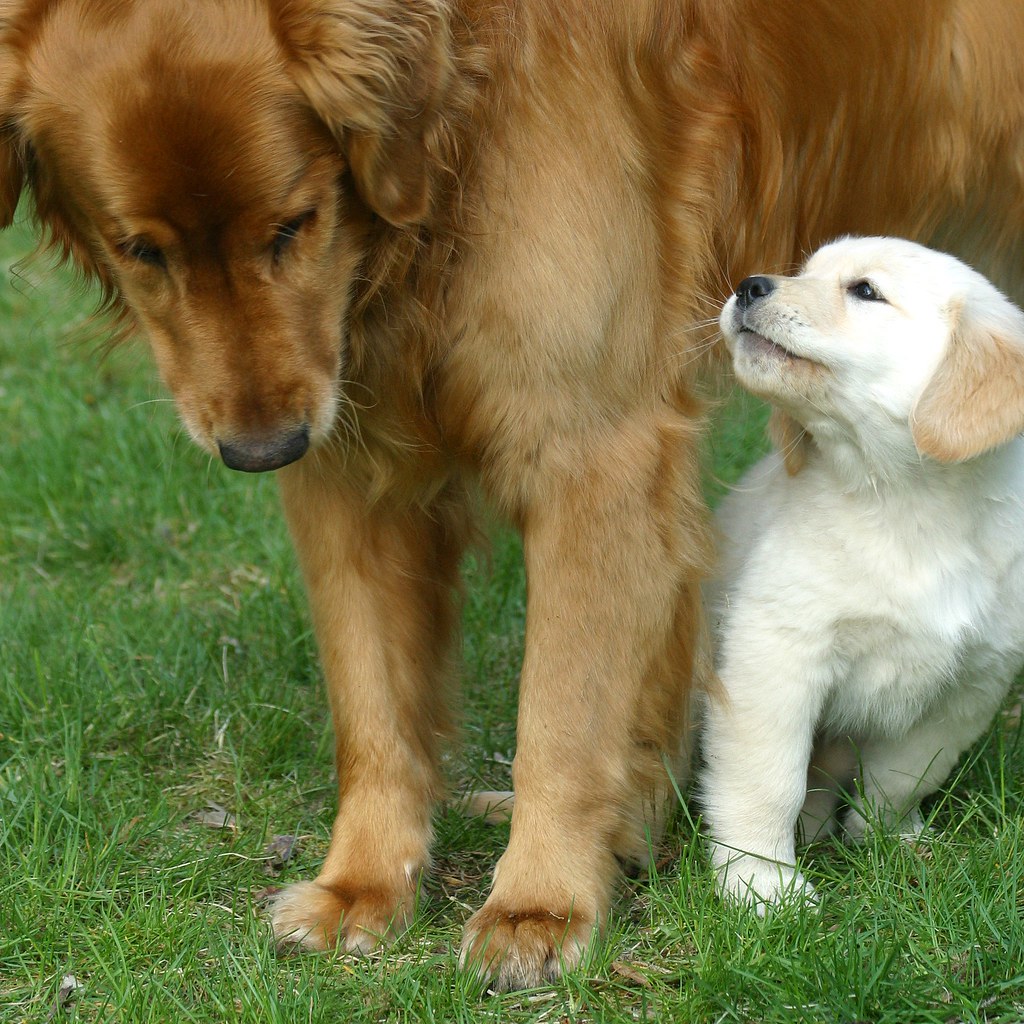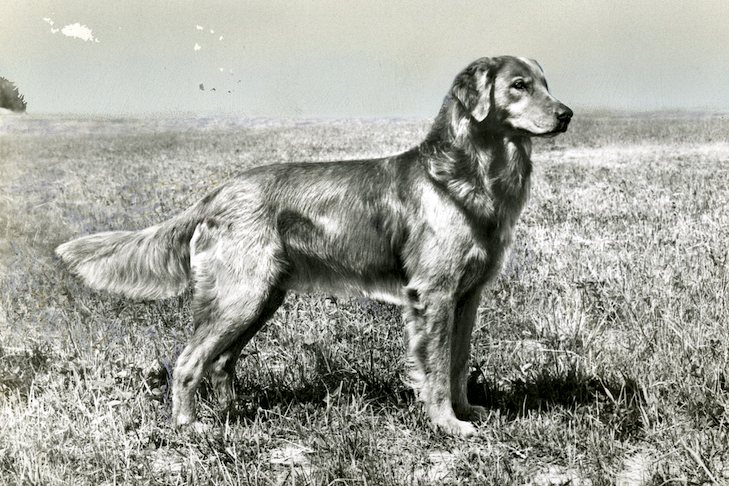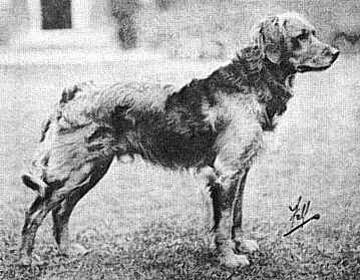Name: Golden Retriever
Breed Age: Recognized by the AKC in 1925
Average Size: 23-24” for males, 21.5-22.5” for females
Average Weight: 65-75lbs for males, 55-65lbs for females
Life Expectancy: 10-12 years
Coat Variations: Dark Golden, Golden, Light Golden
*All breed information comes from the AKC website on Golden Retrievers
Fun Fact: Did you know that the color of the Golden Retriever’s coat used to be considered undesirable?
Golden Retriever Breed History
As is the case with many purebred dogs, the Golden Retriever’s story is centered around one man who had a vision for creating a breed of dog that was specifically suited to the climate, terrain, and other challenges and demands of the area. In the case of the Golden Retriever, that man was Dudley Marjoribanks, the first Lord Tweedmouth, from the Guisachan estate in the Scottish Highlands. Marjoribanks was interested in creating a hunting dog that could handle the rain and rugged terrain near his estate.
Marjoribanks started with what was called a “Yellow Retriever”, an oddity for the day as black hunting dogs were always preferred, and most breeders would get rid of any puppies in a litter who were not black. This “Yellow Retriever” was mixed with a Tweed Water Spaniel, which is now an extinct breed. The next generations were mixed with Irish Setter and Bloodhound, creating a breed that had no trouble on land or in water, had exceptional hunting instincts, and was eager to please its master. Golden Retrievers have been a beloved breed around the world ever since!
Golden Retriever Strengths
- Affectionate
- Great with children
- Great with other dogs/pets
- Eager to please
- Very trainable – used often as service animals
- Friendly
- Happy
- Easy-going
Golden Retriever Weaknesses
- Their coat requires more than average maintenance
- Very active dogs, but they are prone to hip and joint problems early on
- Not always the best guard dogs due to their friendliness
- Their diets should be closely monitored as they can easily become overweight
7 Common Golden Retriever Health Concerns:
Pancreatitis
- The pancreas plays an important role in food digestion by producing hormones like insulin and digestive enzymes to help break down food. When the pancreas becomes inflamed, this is called pancreatitis. It can happen to a dog at any age, and all breeds can be affected. Pancreatitis causes the enzymes produced by the pancreas to be activated before they get to the small intestine, resulting in the breakdown of the pancreas itself. According to VCA Animal Hospitals, “The most common clinical signs include nausea, vomiting, fever, lethargy, abdominal pain, diarrhea, and decreased appetite.” They also describe the behavior to watch for if you think your pet may be experiencing discomfort due to pancreatitis, “During an attack, dogs may take a ‘praying position’, with their rear end up in the air while their front legs and head are lowered onto the floor.” Please bring your pet in immediately if they display any of the above symptoms.
Diabetes
- Diabetes is a metabolism disorder that affects how the body breaks down and utilizes glucose and insulin. It can present as insulin-deficiency, or insulin-resistant. Insulin-deficient means that the dog is not producing enough of its own insulin. Insulin-resistant means that the dog can produce some insulin, but the insulin is not being properly utilized by the body. There is no cure for diabetes, but a dog’s condition can be easily monitored and managed by a veterinarian.
Bloat
- The official term for this health issue is GDV complex, or gastric dilation-volvulus complex. This disease causes the dog’s stomach to fill with air. This rise in pressure cuts off the blood supply returning to the heart, and this reduction in blood volume will send the dog into shock within hours. Watch your pup for a sudden enlargement of their abdomen, coupled with retching, restlessness, excessive salivating, and a tender belly. If you suspect your dog may be at risk for this health condition, please bring them in immediately for a medical evaluation!
Progressive Renal Atrophy
- A genetic disorder characterized by progressive vision loss and eventual blindness in dogs. Currently, the only way to diagnose this disease is to have a specialist veterinary ophthalmologist examine the back of the dog’s eye to test retinal functionality. There are also a few genetic tests that can be administered to young dogs to test for the gene responsible for PRA.
Cataracts
- Most commonly caused by inherited disease, though they can be caused by diabetes and can even occur spontaneously with age. Cataracts usually present much later in a dog’s life. Sometimes they can be removed surgically, but most dogs will retain reasonable sight even with cataracts.
Aortic stenosis/sub-aortic stenosis (AS/SAS)
- From Cornell University College of Veterinary Medicine, “Subaortic stenosis is a narrowing (stenosis) of the area underneath, the aortic valve, that causes some degree of obstruction or blockage of the blood flow through the heart. The narrowing can be mild, moderate, or severe; if moderate or severe, it can force the heart to work harder and potentially be harmful to the heart’s health.” In cases of mild stenosis, your pet may not need treatment, however monitoring the condition with a vet is essential to make sure it does not progress. In more severe cases, medications may be prescribed to help lessen the strain on the animal’s heart.
Hip Dysplasia
- Hip dysplasia is a common skeletal deformation, usually started by a dog’s genetics and exacerbated by weight, exercise, and nutrition. Hip dysplasia occurs when a dog’s hip joint, normally a ball and socket mechanism, does not develop properly. This causes the grinding of the bones in the joint, and can lead to total loss of function of the dog’s leg. Foods that help temper excessive growth can be helpful for puppies of breeds most at risk for hip dysplasia. Maintaining a healthy weight throughout the dog’s life is also crucial, as extra weight only adds more pressure to the at-risk joints. A veterinarian can also recommend joint supplements as part of a preventative treatment plan.
If you have any questions or concerns about your pup’s health, please contact us as soon as possible to address them!






